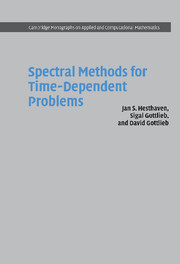Book contents
- Frontmatter
- Contents
- Introduction
- 1 From local to global approximation
- 2 Trigonometric polynomial approximation
- 3 Fourier spectral methods
- 4 Orthogonal polynomials
- 5 Polynomial expansions
- 6 Polynomial approximation theory for smooth functions
- 7 Polynomial spectral methods
- 8 Stability of polynomial spectral methods
- 9 Spectral methods for nonsmooth problems
- 10 Discrete stability and time integration
- 11 Computational aspects
- 12 Spectral methods on general grids
- Appendix A Elements of convergence theory
- Appendix B A zoo of polynomials
- Bibliography
- Index
12 - Spectral methods on general grids
Published online by Cambridge University Press: 04 December 2009
- Frontmatter
- Contents
- Introduction
- 1 From local to global approximation
- 2 Trigonometric polynomial approximation
- 3 Fourier spectral methods
- 4 Orthogonal polynomials
- 5 Polynomial expansions
- 6 Polynomial approximation theory for smooth functions
- 7 Polynomial spectral methods
- 8 Stability of polynomial spectral methods
- 9 Spectral methods for nonsmooth problems
- 10 Discrete stability and time integration
- 11 Computational aspects
- 12 Spectral methods on general grids
- Appendix A Elements of convergence theory
- Appendix B A zoo of polynomials
- Bibliography
- Index
Summary
So far, we have generally sought to obtain an approximate solution, uN, by requiring that the residual RN vanishes in a certain way. Imposing boundary conditions is then done by special choice of the basis, as in the Galerkin method, or by imposing the boundary conditions strongly, i.e., exactly, as in the collocation method.
For the Galerkin method, this causes problems for more complex boundary conditions as one is required to indentify a suitable basis. This is partially overcome in the collocation method, in particular if we have collocation points at the boundary points, although imposing more general boundary operators is also somewhat complex in this approach.Adownside of the collocation method is, however, the complexity often associated with establishing stability of the resulting schemes.
These difficulties are often caused by the requirement of having to impose the boundary conditions exactly. However, as we have already seen, this can be circumvented by the use of the penalty method in which the boundary condition is added later. Thus, the construction of uN and RN are done independently, e.g., we do not need to use the same points to construct uN and to require RN to vanish at.
This expansion of the basic formulation highlights the individual importance of how to approximate the solution, enabling accuracy, and how to satisfy the equations, which accounts for stability, and enables new families of schemes, e.g., stable spectral methods on general grids.
- Type
- Chapter
- Information
- Spectral Methods for Time-Dependent Problems , pp. 235 - 248Publisher: Cambridge University PressPrint publication year: 2007

